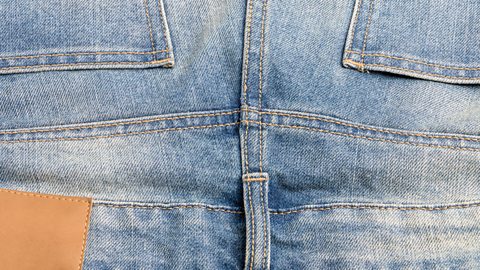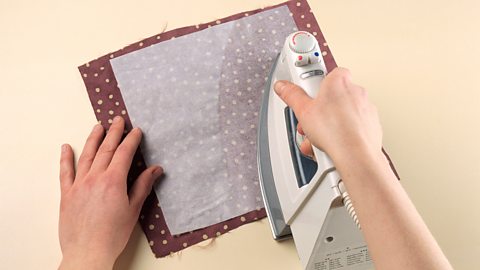Reinforcing and stiffening
Textile materials and componentA part that when put together makes a product. behave differently when subjected to force or stress.
How strong, durable or elastic the textile material is will depend on the fibre source and the construction method of the material or component. Weaker materials can be strengthened by laminatingBonding layers of material together to improve strength., bondingTo attach one material to another with adhesive. or quiltingUsing a running stitch (by hand or machine) through two or more layers of fabric, one of which is wadding. The stitching, once sewn through the layers, creates a padded and decorative effect. .
Fibre source
synthetic fibreA single hair-like strand that is made from chemicals derived from oil. Synthetic fibre examples are polyester and nylon. generally have more tensile strengthTensile strength is the ability of a material to resist pulling forces without snapping, eg a guitar string has high tensile strength. and elasticity than natural fibreA single hair-like strand that comes from a natural source. Natural fibres are either plant, eg cotton, or animal, eg wool, in origin. . A loaded rucksack, a tent pitched in windy weather or a swimming costume all have to be strong, durableHardwearing. and, in the case of the swimming costume, elastic, because of the forces and stresses each experience when in use.
fibreSingle, hair-like strands that derive from either natural or synthetic sources. on their own are not strong but, when twisted into a yarnShort threads spun to form one long thread. they become much stronger. Once the yarns are wovenThreads interlocked to make a fabric. into a fabric they become even stronger.
Kevlar (an aramidAramid fibres are synthetic but they are particularly strong as well as being highly heat resistant. fibre) is five times stronger than steel and because of this it is used for bulletproof vests as well as for protective workwear.
Woven fabric
Woven fabric has more durabilityThe ability to be hardwearing. than knitted fabric, which stretches easily. Although a plain weave is the most common, it is a twill weave that is used to increase the durability of some fabrics. A twill weave creates a diagonal pattern on the fabric surface by crossing the weftHorizontal threads on a loom. and warpVertical threads on a loom. in an offset method, changing each line as the weave progresses. Rucksacks, workwear and jeans all need durability for a long life, so a twill weave will be chosen.
Image caption, Image caption,
1 of 2
Seams
Any seamA seam is usually 1.5 cm wide and is produced by sewing two pieces of fabric together. will produce some element of reinforcement, particularly if double stitched. Many designers will choose a flat fell seamA strong seam that is seen on the right side of the garment and is used where there is a lot of wear and tear, such as the inside leg of jeans. for products that will experience weight stresses, such as jeans and rucksacks.

Bonding
Interfacing
interfacingUsed to add stiffness to a fabric. is a non-woven fabric made from fibres bonded together. The fibres are bonded together by adhesiveA substance which bonds the surfaces of materials together. or stitching, or they are melted. This material is used commonly to reinforceTo strengthen a material that could weaken when a force is applied. and stiffen parts of clothing that will experience a lot of wear, such as shirt collars, cuffs and waistbands. Interfacing, can also be stitched or ironed onto the back of a fabric to improve rigidity or add thickness.

Piping
pipingA fabric covered cord used as a decorative, protective edge to soft furnishing. is a constructional technique used to improve the aestheticHow something looks. of textile products. It also helps to reinforce the seams and as such increase their durability.

Laminating
Laminating is bondingTo attach one material to another with adhesive. two or more fabrics together using an adhesive, rubber or a foam. By bonding fabrics together their properties are combined, improving their function and often reinforcing their strength. Gore-Tex, Permatex and SympaTex are well-known laminated fabrics that are both waterproof and breathable. They are designed to allow body moisture to evaporate away from the body, through the use of a breathable membrane laminatedAt least two layers of material bonded together. between layers of fabric, whilst still remaining waterproof. The membrane has microscopic holes, big enough to let body moisture through but too small for rain, and it is often used in tents and waterproof walking gear.
Quilting
Quilting sandwiches a polyesterA synthetic fibre or fabric that is a derivative of oil. waddingLoose fibres, often polyester, loosely bonded together to help the insulation properties of a textile product. between layers of fabric. They are stitched together, often forming a decorative pattern as a result. Quilting is often used to give warmth to a garmentAn item of clothing., but it can also be used to reinforceTo strengthen a material that could weaken when a force is applied. the fabricās strength and give protection to the wearer, eg the elbows, knees and shoulders of a biker jacket.